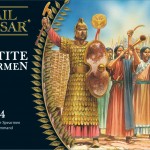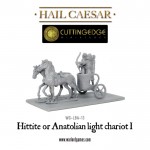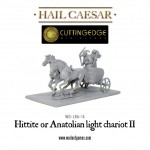In this series of articles, Bronze Age expert Nigel Stillman discusses the Battle of Kadesh and the period of war and battle between the Hittites and Egyptians that led to it:
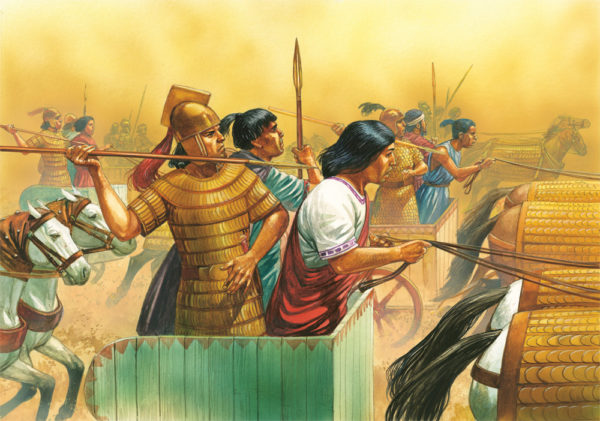
The famous Battle of Kadesh was the climax of a long war fought by the Egyptian Pharaohs and the Kings of the Hittites for control of Phoenicia and Syria. This mass chariot battle of the later Bronze Age is one of the best recorded battles of antiquity, and it can be reconstructed in tactical detail. According to the conventional chronology, the battle was fought in the spring of 1274 BC. The City of Kadesh was on the front line in the wars of the Egyptians, Hittites and Mitanni, and was almost the scene of a clash between the Hittites and Assyrians. There were several battles, sieges and skirmishes around Kadesh and many more in the wider region. It was probably the scene of more chariot fighting than either Megiddo or Troy or anywhere else. This series attempts to put Kadesh in its wider context as well as looking at the battle itself.
Place of Battles
The city of Kadesh on the Orontes (modern Tell Nebi Mend in Syria) stood on a great mound dominating a wide windswept dusty plain and the crossings of the River Orontes. This fortified city was located in a controlling position, being situated upon the route inland to Syria from the Phoenician ports, or looking at it from another point of view; it was in the way of anyone pushing south west towards Phoenicia. From the Egyptians’ strategic viewpoint, holding Kadesh protected Phoenicia, which at the time of Ramesses II was the allied kingdom of Amurru.
Kadesh was a strong city and its rulers had ambitions of their own, but being of the Hurrian chariot warrior nobility (Maryannu), these rulers usually allied with either Mitanni or the Hittites rather than Egypt. Located east of the Lebanese mountains with their Cedar forests, their kingdom outflanked Phoenician city-states whose rulers usually allied with the Egypt. It was a place that would still be of strategic importance in later times. During the Crusades the castle of Krak des Chevaliers was built nearby. To the east are the ruins of the city of Palmyra. In the Bronze Age the open plain of this region was regarded as an ideal place for set-piece decisive battles, rather like Megiddo, and was nicknamed the ‘playground of chariot warriors’ and ‘the scene of battles of all warriors’. In the days of massed chariot warfare you had to choose your battlefield carefully and get there first with the most chariots!
Thutmose III’s Battle of Kadesh (c.1452 BC)
On his First Campaign, Thutmose III of Egypt defeated a coalition of Canaanite princes led by the King of Kadesh at the Battle of Megiddo. On his Sixth Campaign, Thutmose captured Kadesh. A battle on the plain was followed by an assault on the city. The Kadeshites released a mare to cause confusion among the Egyptian chariotry, which were drawn by stallions. The elite soldier Amenemhab ran out of the Egyptian battle lines on foot and killed the mare, presenting her tail to the Pharaoh. At that time Kadesh was a regional power allied to the King of Mitanni. Amenemhab’s tomb biography records his part in the assault; ‘His Majesty sent forth all the elite troops (valiant ones) of his army to be first through the breach in the wall which had been built around Kadesh…He (the Pharaoh) captured the city of Kadesh….I captured two Maryannu (chariot nobles) as prisoners and brought them before the king…He decorated me with gold because of my bravery…’ Thutmose went on to cross the River Euphrates and defeat Mitanni in subsequent campaigns. The next Pharaoh, Amunhotep II, crossed the Orontes and held the frontier against Mitanni. His successor, Thutmose IV made a peace pact with the King of Mitanni and Kadesh remained a vassal of the Egyptian Pharaoh.
Hittites attack Mitanni and take Kadesh (c.1339 BC)
Hittite King Suppililiuma was an ambitious, able and mighty conqueror. He set about the conquest of Mitanni, which for a long time had been making war on the Hittites. He invaded Mitanni and defeated Tushratta, its king, in support of the pretender Artatama, but his real motive was empire building. The Hittite army marched through the kingdom of Kadesh on its way back to Hatti and the Kadeshite king Shuttarna (probably allied to both Egypt and Mitanni) attacked the Hittite army. Suppiluliuma defeated Kadesh, deposed its ruler and put his son, Aitakkama, on the throne of Kadesh. It all happened too quickly for Akhenaten of Egypt, preoccupied with religious reforms, to act in support of Mitanni or Kadesh.
Hittites gain Amurru
The Habiru warlord Abdi-Ashirta and later, his son Aziru, carved out the kingdom of Amurru in the northern part of the Egyptian sphere of influence. They menaced Rib-Addi of Byblos, a loyal vassal of Pharaoh, as well as attacking Egyptian garrisons. Rib-Addi warned Pharaoh Akhenaten of the threat, but Aziru reassured the Pharaoh that he was really an effective buffer against the Hittites. Pharaoh remained inactive. Rib-Addi was deposed in a coup and actually asked Aziru for help to regain his throne, but Aziru handed him over to his enemies. Aziru then made a pact with Aitakkama, king of Kadesh, vassal of the Hittites and rebel against Egypt. The Pharaoh summoned Aziru to Egypt, but the Hittites prepared to invade Amurru. The Hittite general Luppakku marched into Amka (BekaaValley) and general Zitana marched into Nukhash, invading Egyptian territory. Pharaoh released Aziru to lead the defence of Amurru, but he immediately defected to the Hittites.
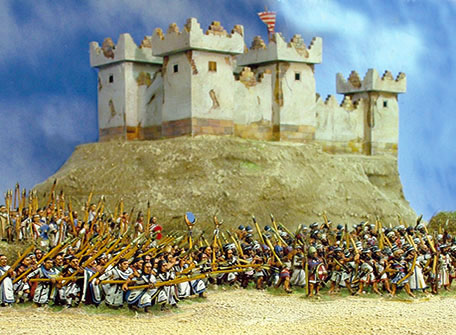
Egypt tries to retake Kadesh
At this moment Akhenaten may have sent Egyptian forces against the Hittites, but these were repulsed. In Tutankhamun’s ‘Restoration Stela’ recording his decision to reverse his father’s religious reforms, it is made clear that Egypt’s bad luck is blamed on the old gods withholding their support for the regime because Akhenaten had neglected and offended them. It states; ‘when an army was sent to Syria to extend the frontiers of Egypt it met with no success’.
Shortly after this setback, Akhenaten’s reign ended and Tutankhamun ascended the throne. Advised by the generals Ay and Horemhab, the policy of the regime changed, and the edict recorded on the stela was proclaimed. Recent discoveries of inscribed blocks at Luxor temple in Egypt reveal that Tutankhamun and his general Horemhab campaigned in the region of Kadesh. It is not certain whether the city was retaken and it seems very unlikely. Later the scenes were dismantled, reused and hidden, possibly during the reign of Horemhab, perhaps because Horemhab was not the commander on this campaign and it may have been a rival general such as Min-Nakht. In dismantling the scenes, the first depictions of three crew chariots in use by Hittite allies were hidden and so the tactic came as a surprise to Ramesses II a generation later (although we might wonder whether Seti I encountered them.) Perhaps the tactic originated as a battlefield innovation that proved effective and later became standard tactics.
Read the other Sections of this article:
History: The Battle of Kadesh part 1
History: The Battle of Kadesh part 2
History: The Battle of Kadesh part 3
History: The Battle of Kadesh part 4
History: The Battle of Kadesh part 5

